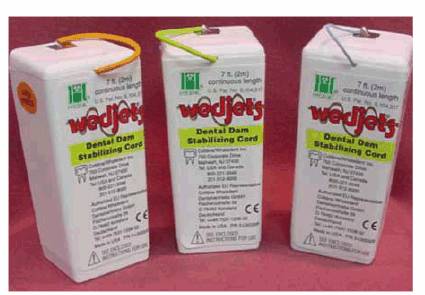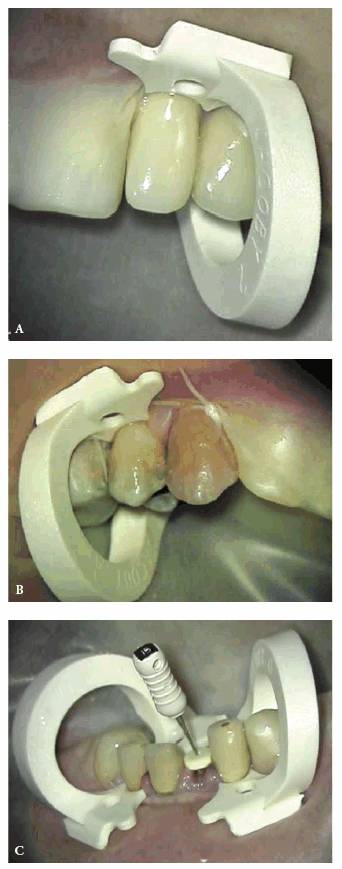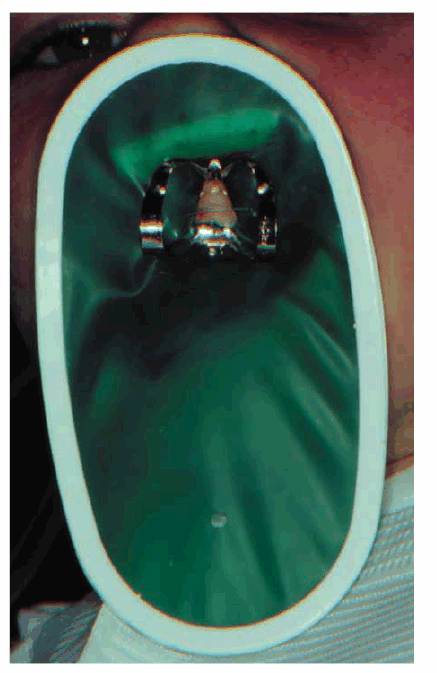ENDODONTICS AND ESTHETIC DENTISTRY(11)
Rubber Dam
The use of the rubber dam is regarded as mandatory in endodontics. However, isolating teeth decayed below the gingival crest or restored with all-ceramic crowns presents unique problems that invite a departure from the standard of care. It must be remembered that an untoward incident (ie, swallowing or aspirating a reamer or file when the rubber dam has not been used during therapy) leaves little doubt about legal liability.
The market offers a variety of rubber dam clamps designed to fit almost every situation. Crown lengthening prior to endodontic treatment is often required to expose sufficient tooth structure to clamp. This is not a detriment since lengthening procedures will be beneficial when the restorative dentist is establishing a finishing line for the restoration. The effect of a rubber dam clamp on porcelain or cast glass restorations can be esthetically devastating. Madison et al. studied the problem in a laboratory model.17 The clamps were placed on the crowns and left undisturbed for 1 hour. They found that regardless of the crown margin design, all of the test samples displayed crazing of the porcelain in the area of the beaks of the clamp. Additional forces on the porcelain in clinical situations as the clamp is inadvertently moved during treatment would most certainly be destructive. As previously discussed, this problem could be eliminated if all teeth having questionable pulpal health were endodontically treated prior to cementation of the crown. The retentive value of the abutment would be increased, and damage to the porcelain would be avoided if elective endodontics preempted the crown fabrication and/or cementation.
Since over 40% of root canal treatment is performed through existing castings, the following alternative methods of rubber dam application are suggested for porcelain and cast glass crowns:
1. Floss or rubber cord ligation. Dental floss or Hygenic's rubber cord "Wedjets" (Figure 19-39A) can be used to retain a rubber dam when isolating a single tooth. Wedjets is a stretchable cord that is made from natural latex. The cord, available in three sizes, is placed like dental floss to hold the dam in place. Wedges can be used in conjunction with dental floss or Wedjets once the dam is in place. For convenience, it is recommended that at least one tooth on either side of the treated tooth be included in the isolation (Figure 19-39B).

Figure 19-39A: Wedjets (Hygenic), three sizes.

Figure 19-39B: Wedjets stabilizing the rubber dam and aiding in the isolation of a maxillary central incisor.
2. Multiple teeth isolation. This technique suggests that the clamps be placed on unrestored adjacent teeth. Three or more contiguous holes are punched in the dam, and the rubber is stretched over all of the teeth to be isolated; the tooth to be treated remains unclamped, and access is unrestricted (Figures 19-40A and B).

Figure 19-40A and B: Rubber dam isolation of multiple teeth.
3. Jacoby plastic clamps. Bay Technical Products (
4. Cushee rubber dam clamp cushions (Practicon). Cushees are soft silicon cushions that fit over the jaws of standard steel clamps. The jaws of the clamp do not come in contact with the gingiva, tooth structure, or restoration. Patient comfort is increased, and potential damage to porcelain and cast glass is decreased. They are available in two sizes: yellow for anterior and bicuspid clamps (Figures 19-42A and B) and blue for molar clamps (Figure 19-42C).
5. Ingenuity. When dealing with splinted units, ingenuity becomes part of the problem-solving equation. A triple-width hole is punched, and the teeth adjacent to the treated tooth are clamped. Once the dam is in place, Cavit (3M ESPE, St. Paul, MN), Provit (E.C. Moore, Dearborn, MI), or Oraseal Putty (Ultradent, South Jordan, UT) is compacted around the gingival margin of the crown to block off the expected leakage. When the entire arch is a porcelain-fused-to-metal or cast glass crown, you are faced with a most difficult situation and must improvise esthetic damage control. If there are individual crowns, you avoid placing rubber dam clamps on any of the anterior or first premolar teeth. Surface damage to the porcelain, when risked, should be confined to the second premolar and molar teeth, which are less visible in most situations. Cushees, Jacoby clamps, or Wedjets should be used to protect the restorations.
Again, for both contamination and patient protection, as well as medicolegal reasons, endodontic treatment should never be attempted without rubber dam isolation. Nonlatex dam is available from Hygenic for those patients with known latex allergies. Apprehensive patients may be accommodated with the use of Quick dam (Figure 19-43) from Ivoclar Vivadent (

Figure 19-41A to C: Jacoby rubber dam clamps (Bay Technical Products) isolating (A) lateral incisor, (B) premolar and canine, and (C) multiple teeth.

Figure 19-42A to C: Cushee rubber dam clamp (Practicon) cushions isolating (A) multiple anterior teeth, (B) maxillary premolar, and (C) mandibular molar.

Figure 19-43: Quick dam.
- on 01.11.2012 [endodontics]
- on 01.11.2012 [endodontics]
- on 01.11.2012 [endodontics]
- on 10.13.2011 [endodontics]
- on 12.15.2010 [endodontics]
- on 08.11.2010 [endodontics]
- Long Island College Hospital - [education]
- Faculty of Dental Medicine - H [education]
- The American Association of Or [organize]
- Summer Institute in Clinical D [organize]
- Academy of Osseointegration [organize]
- University of North Carolina a [education]
- American Orthodontic Society [article]
- American Equilibration Society [article]
- Niigata University - Japan [education]
- University of Buffalo [education]